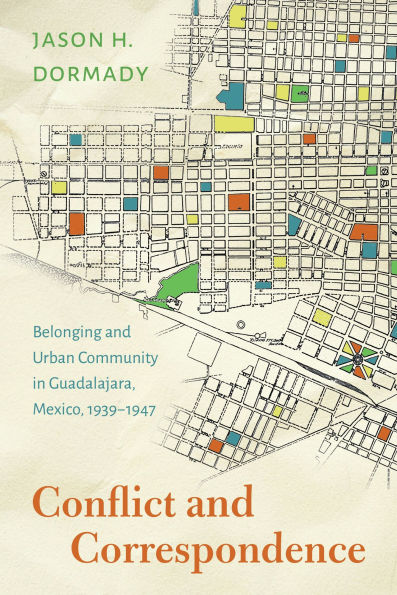Conflict and Correspondence: Belonging and Urban Community in Guadalajara, Mexico, 1939-1947
In the decades following the 1910 Mexican Revolution, Guadalajara faced immense demographic and economic transformation, stunning both longtime residents and new arrivals. The city's population nearly tripled from 1920 to 1950, and the resultant population boom strained government resources and challenged living standards for all. In Conflict and Correspondence Jason H. Dormady examines the critical transition period when Guadalajara lost control of urban growth after 1939 and when the newly empowered state and federal governments began to exercise immense control over the development of the city in 1947. As the city changed around them, residents used petitions and letters to municipal officials to help address their feelings of alienation, isolation, and separation from the community around them. Petitions took the form of sensate, moral, recreational, spiritual, and gendered arguments about creating livable communities and avoiding the disorientation experienced by urban transformation. In the context of infrastructure failures, tight housing markets, and a dramatic aesthetic transition, petitions on these topics reinforced to residents--and, they hoped, city officials--their belonging to the community. Resident petitions reveal how everyday people lived the consequences of the 1910 revolution as they advocated for shaping space and building place in midcentury Guadalajara.
1146722587
Conflict and Correspondence: Belonging and Urban Community in Guadalajara, Mexico, 1939-1947
In the decades following the 1910 Mexican Revolution, Guadalajara faced immense demographic and economic transformation, stunning both longtime residents and new arrivals. The city's population nearly tripled from 1920 to 1950, and the resultant population boom strained government resources and challenged living standards for all. In Conflict and Correspondence Jason H. Dormady examines the critical transition period when Guadalajara lost control of urban growth after 1939 and when the newly empowered state and federal governments began to exercise immense control over the development of the city in 1947. As the city changed around them, residents used petitions and letters to municipal officials to help address their feelings of alienation, isolation, and separation from the community around them. Petitions took the form of sensate, moral, recreational, spiritual, and gendered arguments about creating livable communities and avoiding the disorientation experienced by urban transformation. In the context of infrastructure failures, tight housing markets, and a dramatic aesthetic transition, petitions on these topics reinforced to residents--and, they hoped, city officials--their belonging to the community. Resident petitions reveal how everyday people lived the consequences of the 1910 revolution as they advocated for shaping space and building place in midcentury Guadalajara.
99.0
Pre Order
5
1

Conflict and Correspondence: Belonging and Urban Community in Guadalajara, Mexico, 1939-1947
244
Conflict and Correspondence: Belonging and Urban Community in Guadalajara, Mexico, 1939-1947
244
99.0
Pre Order

Product Details
| ISBN-13: | 9781496229526 |
|---|---|
| Publisher: | Nebraska |
| Publication date: | 12/01/2025 |
| Series: | Confluencias |
| Pages: | 244 |
| Product dimensions: | 6.00(w) x 9.00(h) x (d) |
About the Author
From the B&N Reads Blog
